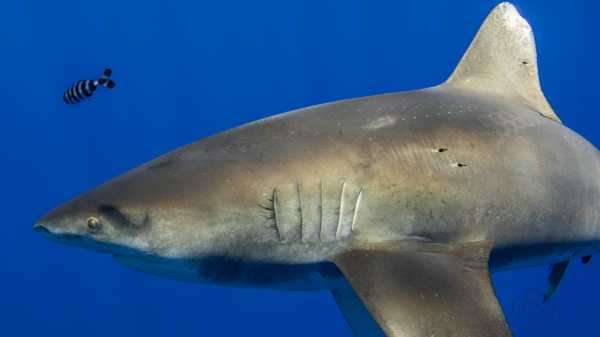
Mysterious scars on this whitetip shark suggested it had battled with the elusive giant squid off Hawaii.
A rare, multispecies brawl unfolded recently in the deep ocean off the coast of Hawaii. In one corner, an oceanic whitetip shark (Carcharhinus longimanus) — a 7-foot-long (2.1 meters) predator capable of diving up to 1,000 feet (300 m) below the surface in pursuit of prey. In the other corner… it’s not clear. But whatever it was, it was huge, it had tentacles and it put up a hell of a fight.
Undersea photographer Deron Verbeck caught the aftermath of this mysterious scrap when he snapped a picture of the offending shark, scarred all along its flank with strange circular patterns and dots. According to a study published June 3 in the Journal of Fish Biology, there are only a handful of creatures in Hawaiian waters capable of creating scars like that, and they are all enormous cephalopods.
While it’s impossible to be sure what exactly scarred the shark, the researchers argue that it could have been a “phantom of the deep” — another name for the elusive giant squid (Architeuthis dux).
Giant squids are mysterious denizens of the deep ocean, thought to be able to grow anywhere from 33 to 43 feet (10 to 13 m) in length. They are poorly studied because they live so deep underwater — typically about 1,000 feet (300 m) down or more, the researchers wrote. Their deep dwellings put the giant squids not only out of reach of most humans, but also many would-be predators.
The oceanic whitetip shark may be an exception, the researchers wrote. Because the sharks are known to dive to extreme depths on foraging missions, it’s feasible that an unlucky whitetip could find itself snoot-to-sucker with a giant squid.
That may be what happened to the scarred shark in the photo. According to the researchers, the series of circular marks along the shark’s back and side are shaped exactly like the suckers on a large squid’s tentacles. From the size of the markings, the offending squid must have been at least the same size as the shark (at least 7 feet, or 2 meters, long) and was possibly even larger, the researchers wrote.
Only three types of squids known to inhabit Hawaiian waters could have created the marks, the team concluded: a squid in the genus Thysanoteuthis or Megalocranchia (both known to grow up to nearly 7 feet) or the giant squid.
Many other details of the encounter remain a mystery. For example, who threw the first punch? (Or bite? Or slap?) According to the researchers, this is the first time such large tentacle markings have been observed on a shark, so it’s hard to say whether the shark was acting in offense or defense. However, “the lack of any obvious wounding suggests they were more likely defensive (i.e. the shark attacked the cephalopod),” the researchers wrote in the study. “Similar scarring patterns are seen on sperm whales, well-known predators of large cephalopods.”
When pressed for details on the encounter, the shark responded merely: “You should see the other guy.”
Sourse: www.livescience.com





